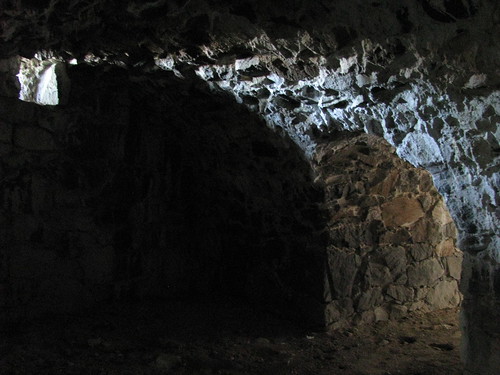tags: Suomenlinna, Helsinki, Finland, image of the day
Pohjolan kivimäkehen.
Photographed at Suomenlinna on Kalevalapaäivä (Kalevala Day).
This is one of my favorite places to visit in Helsinki, Finland.
Image: GrrlScientist, 28 February 2009 [larger view].
Kun oli kuun kulettanunna sekä päivän saattanunna
Pohjolan kivimäkehen, rautaisehen kalliohon,
jopa valkean varasti, tulen Väinölän tuvilta:
sai tuvat tulettomaksi, pirtit valkeattomaksi.
Jo oli yö alinomainen, pitkä, pilkkoisen pimeä.
Oli yö Kalevalassa, noilla Väinölän tuvilla
sekä tuolla taivahassa, Ukon ilman istuimilla.
Tukela on tuletta olla, vaiva suuri valkeatta,
ikävä inehmisien, ikävä itsen Ukonki.
-- Kalevala, Runo 47: "Louhi Steals Sun, Moon, and Fire" (originaali teksti).
English translation:
When the golden Moon had vanished,
And the silver Sun had hidden
In the iron-banded caverns,
Louhi stole the fire from Northland,
From the regions of Wainola,
Left the mansions cold and cheerless,
And the cabins full of darkness.
Night was king and reigned unbroken,
Darkness ruled in Kalevala,
Darkness in the home of Ukko.
-- Kalevala, poem 47: "Louhi Steals Sun, Moon, and Fire" (original text).


Forgive my probably pointless comment, but I just wanted to mention that your post brought a smile to my face. I think I've stood precisely where that photo was taken.
I have many happy memories of my time exploring Suomenlinna during my time in Helsinki. It seemed particularly mysterious at night, but that was probably just my imagination.
Regardless, thanks for including the photo and the poem.
The photo has a very mysterious look about it. I like it! Is it a cave or does it just look that way because of shadows? If it is a cave, what's inside?
Suomenlinna, which means something like "Finnish fortress" or "Finnish castle", is a military fortress that was built by the Swedes in 1700s to limit Russians expansionism. The image was taken during the middle of a very sunny, cold day (as you will see in future images) from inside one of those fortress rooms. it feels very cave-like to be inside the fortress, but it's definitely a man-made structure, as you can see from the square window that the sun is shining into.
Some people think that this poem about the evil Louhi stealing the sun, has actual historical connections. Some Scandinavian mythology also talk about a three year winter ("Fimbulvinter"). All these could match with a period of extremely slow growth in 535-536 AD observed in the tree growth rings, which then has been connected to a volcanic eruption (of the Krakatau?). I guess all this is heavily debated, some connect it to a unfavourable conditions around 300 BC. Anyway, it must have been something extraordinary (more than October-March night occurring every year...).
Nice photo! Cheers, j